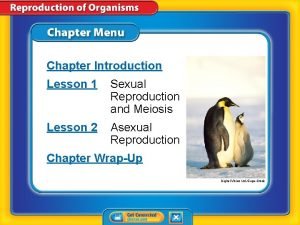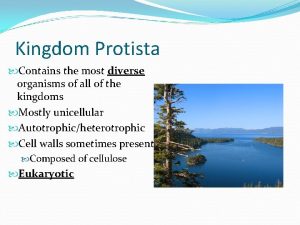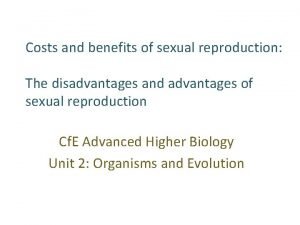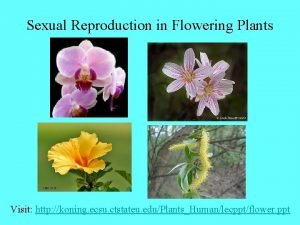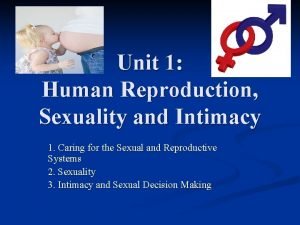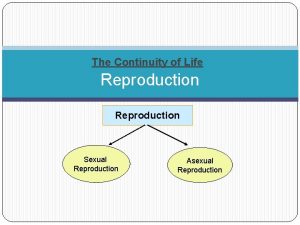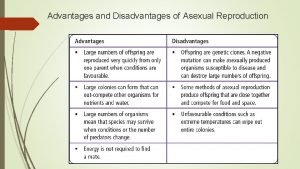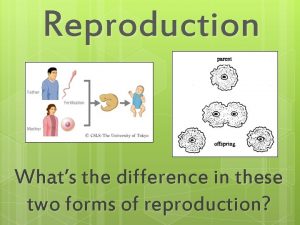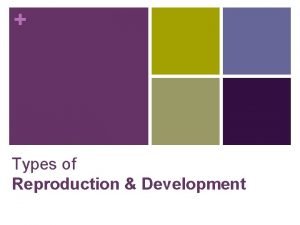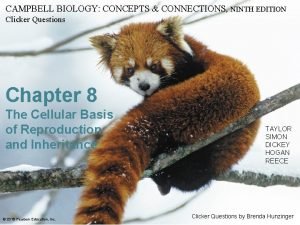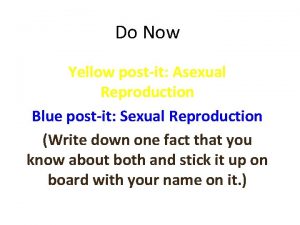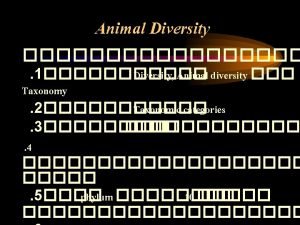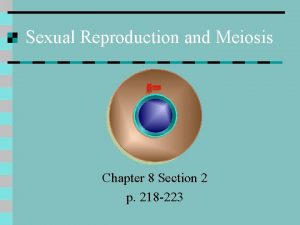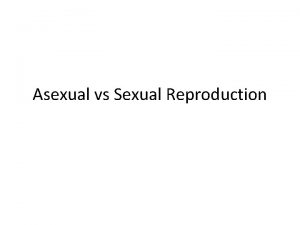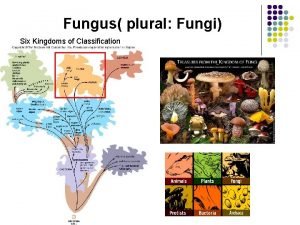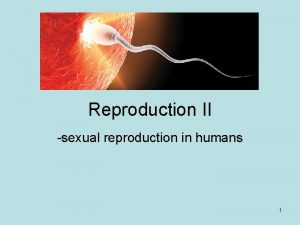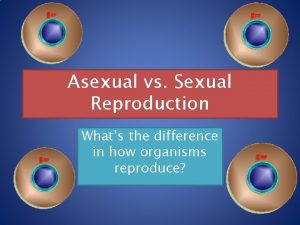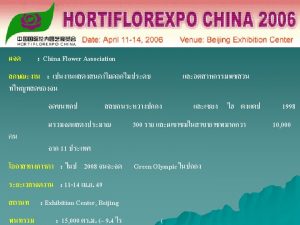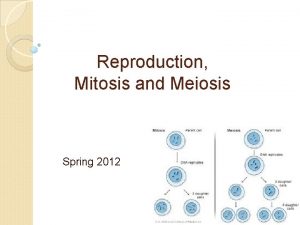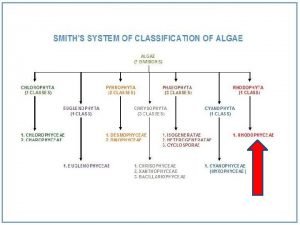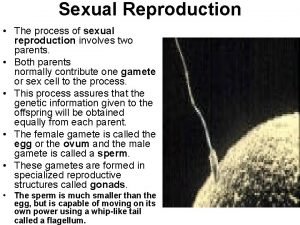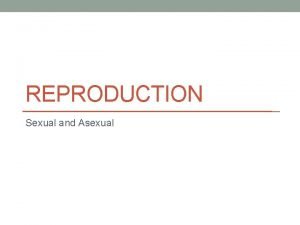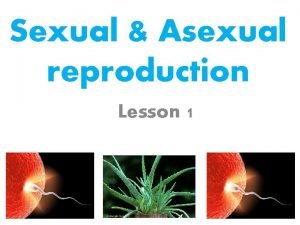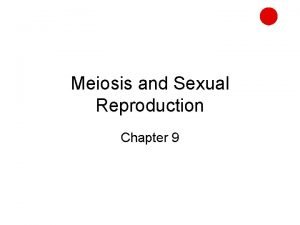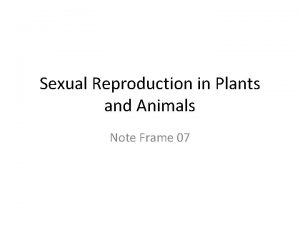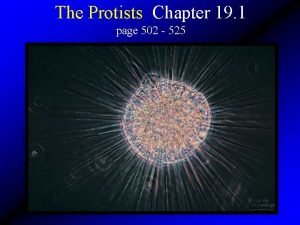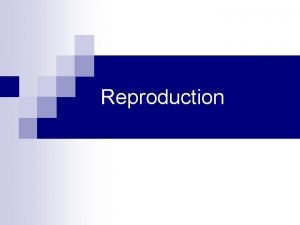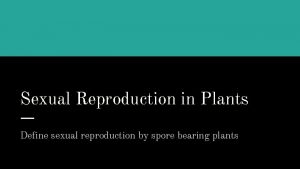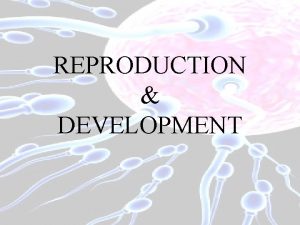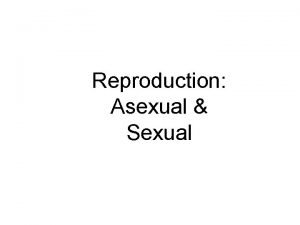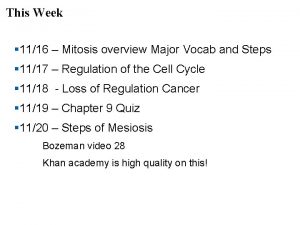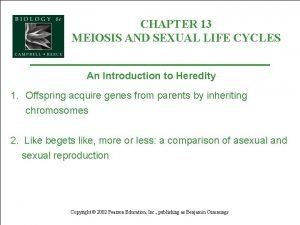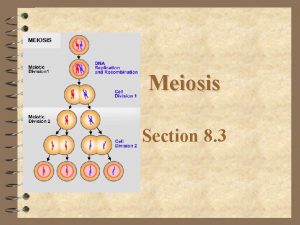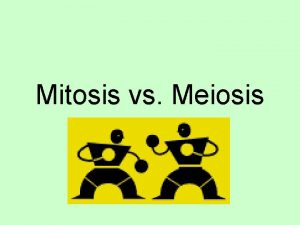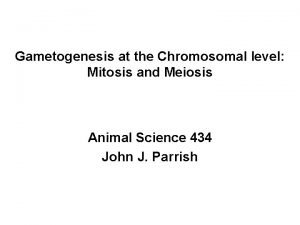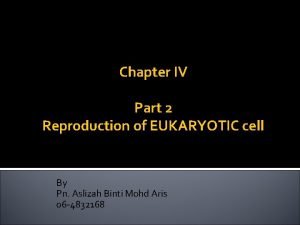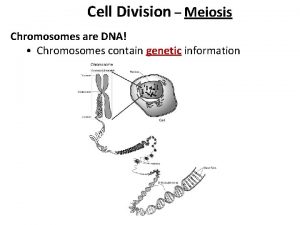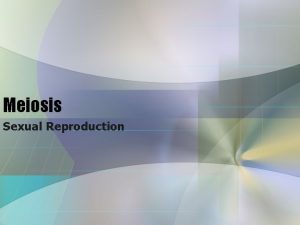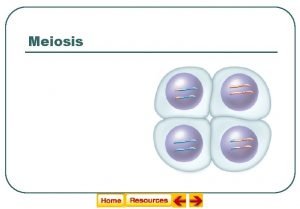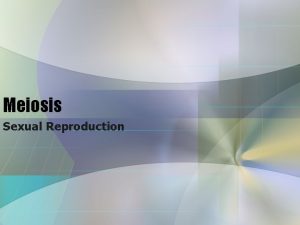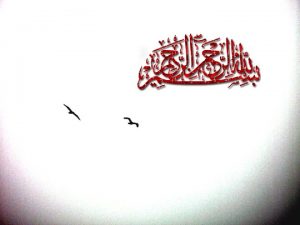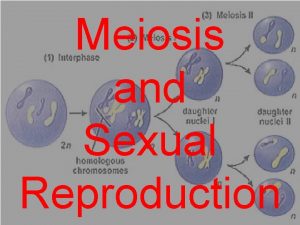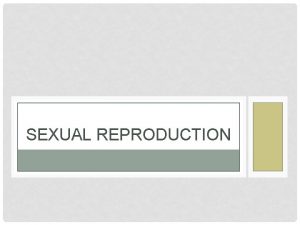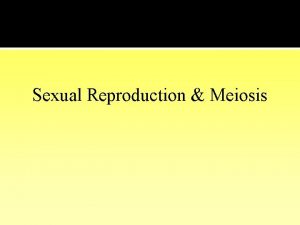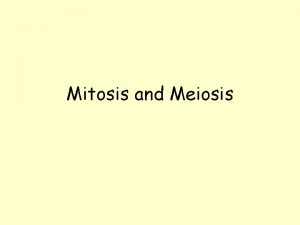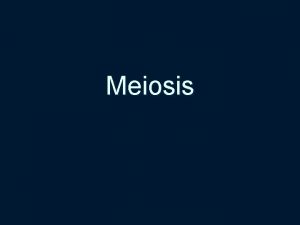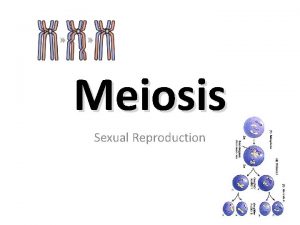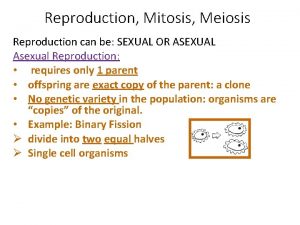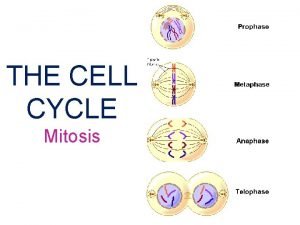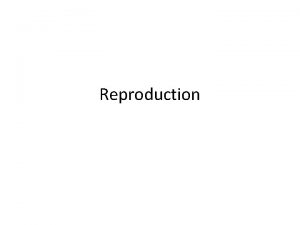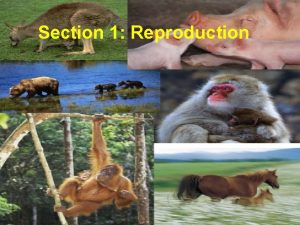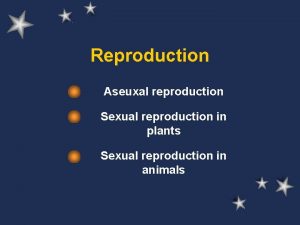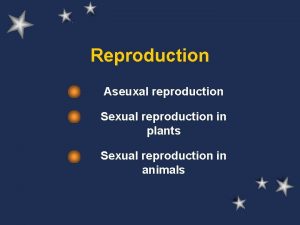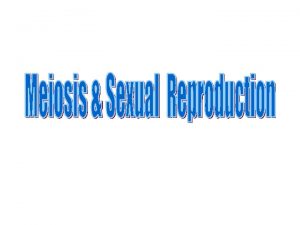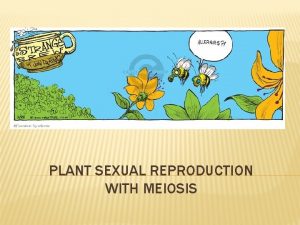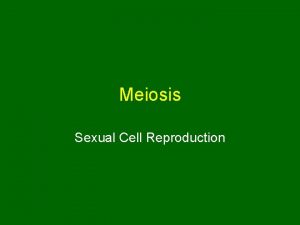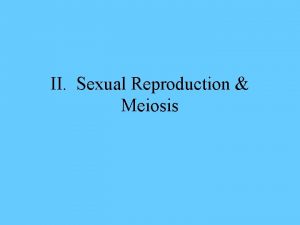Meiosis Sexual reproduction Mitosis v Meiosis There are



























































- Slides: 59

Meiosis Sexual reproduction

Mitosis v Meiosis There are many similarities between mitosis and meiosis. Both are involved in the division of DNA during cell division and both share similar naming systems as far as their phases are concerned. However the cells produced at the end of a mitotic division are very different to the cells produced at the end of a meiotic division.

Mitosis v Meiosis Following mitosis and cytokinesis two daughter cells are produced with identical DNA to the original cell. Remember cell theory states that all cells come from existing cells. Mitosis is considered asexual reproduction as the DNA not altered during of the process. Due to the ways in which chromosomes line up during meiosis the cells produced at the end are genetically different to the parent cell and to each other. For this reason we term meiosis sexual reproduction.

Mitosis v Meiosis As we know we share 50% of our DNA with each of our parents. We are however very different from our parents and although we may share many similar traits to them we are also unique. Sexual reproduction involves the combining of one parents DNA (paternal – male) with another parents DNA (maternal – female).

Meiosis Likewise we are not an exact 50/50 split of our parents even though we got 50% of our DNA from each of them. At some point their DNA has been combined but prior to that it has also been mixed up and entirely new combinations of genes have been made.

Fertilization is the point where-by the genetic information from each parent is combined. Fertilization is the fusion of a sperm and an egg to form a zygote. A zygote is a fertilized egg it has the diploid number of chromosomes.

Formation of a Zygote

Heredity and Genes A gene is the molecular unit of heredity in an organism. A gene is the scientific name given to a stretch of DNA that codes for the production of a specific polypeptide chain. Proteins are made from numerous polypeptide chains. We are made of proteins and many of the chemical reactions that happen in our bodies are catalyzed by proteins (enzymes).

Homologous Chromosomes Homologous chromosomes are pairs of chromosomes that contain the same gene but may have different alleles for those genes. An allele is a variant of a gene. Typically genes have more than one version that whilst it wont be expressed is still in the organisms gene pool. For example if you have brown eyes you will have a gene that codes for brown pigment but you may also have the gene that codes for blue pigment.

Genetic Information All of your cells contain all of the information that make you, you. They also contain another set of information that is not expressed. This could be because the information is recessive or perhaps identical to the genes being expressed. We will cover the terms dominant and recessive when we go on to look at genetics.

Homologous Chromosomes One of the chromosomes, in the homologous pair, came from the father and one came from the mother. In Mitosis we saw sister chromatids. These are chromosomes that have the exact same gene and alleles and are joined at a centromere. In meiosis the homologous chromosomes pair up and form what is known as a tetrad.

Sister chromatids v Homologous Chromosomes The way in which chromosomes are aligned into homologous pairs and undergo a second division of DNA will, as we will see, result in gametes which are unique and which contain only half the genetic information of the original parent cell. Note the locus of each gene is the same in each homologue.

The Human Genome The human genome consists of 46 chromosomes. There are 23 pairs of chromosomes (23 x 2=46) Out of the 23 pairs 22 are termed autosomes. These are the chromosomes that code for many of our traits such as; hair color, eye color, or height. The other pair of chromosomes are the sex chromosomes. In males these are X and Y, in females they are X and X.

The Human Genome Karyotype

Haploid and Diploid When a cell contains double the genetic information it is said to be diploid (meaning two sets) When a cell contains only one set of information it is said to be haploid (meaning one set) The gametes (sperm and eggs) of sexually reproducing organisms contain only a single set of chromosomes and therefore only a single set of genes (they are haploid). Diplod is often expressed as 2 n and haploid is often expressed as n.

Gametes and Somatic Cells Somatic cells: are “body cells” that contain the diploid number of chromosomes. Gamete cells: are the cells that make up our sperm and eggs. They contain the haploid number of chromosomes. This is vital to ensure that the amount of DNA we have is not increasing with each successive generation. Polyploidy cells have an extra set of chromosomes per set. They are defined as being 3 N.

Meiosis is the method by which gametes are created which contain the haploid (N) number of chromosomes. In addition the process of ‘crossing over’ will also result in a further mixing of genetic information, creating brand new unique chromosomes. By combining two haploid gametes we create a new, unique, diploid zygote. This forms the basis of heredity and evolution.

Division of DNA in Meiosis During meiosis chromosomes first line up in homologous pairs (tetrads) Meiosis as we will see involves another round of DNA division. The end result of these two rounds of division is to leave cells with 50% of the genetic information Moreover the cells formed through meiosis have one set of alleles (form of a gene). This means that when gametes combine during reproduction the resulting cells that are created will contain a full compliment of DNA.

Crossing-over During an early phase of meiosis (meiosis I) a process known as crossing-over occurs. During crossing-over alleles are exchanged between homologous chromosomes (nonsister chromatids) creating brand new, unique combinations of alleles

Crossing-over

The process of Meiosis During Meiosis the number of chromosomes, per cell is cut in half through the separation of the homologous chromosomes. This results in 4 haploid cells that are genetically different from one another and from the original cell. For this reason meiosis is not a cycle.

The Process of Meiosis

Interphase 1 Cells undergo a round of DNA replication Duplicate chromosomes are formed

Meiosis 1

Prophase 1 Each chromosome pairs with its corresponding homologous chromosome. The resulting structure is called a tetrad. This is when the process of crossing-over occurs. The nuclear envelope starts to break down.

Prophase 1

Metaphase 1 Spindle fibers attach to the chromosomes- note that the spindle has attached to each tetrad and not to individual chromatids as in mitosis. This will result in one chromosome being pulled to one side and the other homologue being pulled to the other side. This is where we see Mendel’s law of independent assortment and segregation in effect as homologous pairs line up randomly toward each pole – 1 allele will end up at each pole and traits on different chromosomes will be independent of each other.

Metaphase 1

Anaphase 1 The spindle fibers pull the homologous chromosomes toward opposite ends of the cell Note that this differs from mitosis as the sister chromatids are still attached to each other but the homologous chromosomes are now separated (n). In genetics we term this independent assortment. This means that each cell produces will only have one of the genes for a specific trait. In mitosis the sister chromatids are separated but each resulting daughter cell still has a copy of every chromosome (2 n).


Telophase 1 and cytokinesis Nuclear membranes form The cell separates into two cells The cell Now has the haploid number of chromosomes.

Meiosis 2

Prophase 2 Meiosis 1 resulted in two haploid (N) daughter cells each with half the number of chromosomes as the original cell. The 2 cells contain half the number of chromosomes but each chromosome has a copy Each chromatid is genetically different, thanks to crossing over.

Prophase 2

Metaphase 2 The chromosomes line up along the metaphase plate. This is similar to the metaphase in mitosis The only real difference at this stage is the fact that each cell is haploid and the copies of each chromosome are different.

Metaphase 2

Anaphase 2 The chromosomes separate The spindle pulls the chromosomes toward opposite poles of the cell. As in mitosis anaphase 2 ends when the chromatids stop moving.

Anaphase 2

Telophase and Cytokinesis Telophase and cytokinesis continue in much the same way as in mitosis. The nuclear envelopes reform, the chromosomes unravel into chromatin. Finally the cytoplasm is distributed amongst the new cells. Meiosis 2 results in 4 haploid (N) daughter cells.

Telophase 2 and Cytokinesis 4 haploid (N) daughter cells Each cell is genetically different from the original and from each other.

Focus on the Chromosomes

Gamete Formation

Gamete Formation - Plants

Mitosis v Meiosis

Mitosis v Meiosis

Number of Cell Divisions Mitosis is a single cell division that results in two identical daughter cells, with a diploid set of chromosomes. Meiosis contains a second round of cell divisions and in most cases produces a total of four daughter cells that are genetically different and contain a haploid set of chromosomes.

Independent Assortment Now that we have seen meiosis and understand how it works one further problem with Mendel’s principle of independent assortment appears. The principle of independent assortment states that genes of different traits can segregate independently during the formation of gametes. However if two genes lie close to each other on the same chromosome we often see that both are inherited together.

Gene Linkage This is known as gene linkage and was first discovered by Thomas Hunt Morgan in 1910 when he realized that certain seemingly unrelated traits of fruit flies were almost always observed together. Hunt Morgan observed that flies with miniature wings almost always had red-brown eyes. They then discovered that fruit flies had 4 such linkage-groups and 4 chromosomes.

Gene Linkage Morgan Hunt concluded that Mendel’s principle of independent assortment still held true but that it was chromosomes that assorted independently and not individual genes. When two genes are close together on the same chromosome there is a very high probability that they will be inherited together. By luck Mendel did not observe this as the traits he examined were in different chromosomes or so far apart on the same chromosome that they assorted independently.

What Happens when Meiosis Goes Wrong? After meiosis has occurred we are left with 4 haploid cells. This is very important as it ensures we inherit the right number of chromosomes from each of our parents. If the chromosomes fail to separate properly we can see some severe genetic disorders.

Non-disjunction Cell division were chromosomes fail to separate properly is called non-disjunction. If nondisjunction occurs during meiosis I or II the resulting gametes will not have the right number of chromosomes. Non-disjunction can result in extra copies of a particular chromosome or only one copy.

Trisomy and Monosomy Having an extra copy of a chromosome is called trisomy. Having only one copy of a particular chromosome is called monosomy. Non-disjunction can occur in any organism which produces gametes by meiosis. Alterations in chromosome numbers can result in serious genetic disorders in humans.

Downs Syndrome Down syndrome is a result of an extra chromosome 21. For this reason it is often called trisomy 21. Down syndrome results in distinctive facial features, short stature, heart defects, and mental disability. Approximately 1 in 800 people born in the US has down syndrome. The risk of giving birth to a child with down syndrome increases with age.

Nondisjunction of Sex Chromosomes Turners syndrome results from having only one sex chromosome (X) in females. People with turners syndrome may have short stature, a broad chest, low hairline, low -set ears, and a webbed neck. Women with turners syndrome are usually infertile and experience amenoreah (absence of menstrual cycle).

Nondisjunction of Sex Chromosomes Females with a XXX set of sex chromosomes will be nearly normal. XXY males will have Klinefelter’s syndrome. XYY males are nearly normal. 0 Y genotype results in death.

Dominant and Recessive Genetic Disorders Many genetic disorders will be the result of having two recessive genes. People who have on recessive gene for a genetic disorder are called carriers. Sometimes there are evolutionary advantages to being a carrier but not double recessive. For example people who are heterozygous dominant for the gene which causes sickle cell anemia.

Dominant Disorders Some genetic disorders are caused by the dominant gene. In these disorders people who don t have the gene are homozygous recessive. These types of disorder can cause things like Huntington’s disease – a nervous system disorder resulting in loss of brain function.

Gene Maps In 1911 one of Moran Hunts students at the University of Colombia , Alfred Sturtevant, came up with an idea that you could study the rates of independent assortment of genes on the same chromosome to map out the locations of genes. If two genes are far apart then there is a higher probability that crossing-over will occur. If they are close together crossing-over will be less likely. His technique for mapping chromosomes is still used today.

Human Gene Map for Physical Fitness and Health Related Performance.
 Venn diagram of sexual and asexual reproduction
Venn diagram of sexual and asexual reproduction Asexualk
Asexualk Venn diagram asexual vs sexual reproduction
Venn diagram asexual vs sexual reproduction Mitosis sexual reproduction
Mitosis sexual reproduction Mikael ferm
Mikael ferm Sexual reproduction and genetics section 1 meiosis
Sexual reproduction and genetics section 1 meiosis Sexual reproduction and genetics section 1 meiosis
Sexual reproduction and genetics section 1 meiosis Connecting the concepts sexual reproduction
Connecting the concepts sexual reproduction The kingdom protista contains
The kingdom protista contains 11/15
11/15 Disadvantage of sexual reproduction
Disadvantage of sexual reproduction Sexual reproduction
Sexual reproduction Sexual reproduction in human
Sexual reproduction in human Sexual or asexual reproduction
Sexual or asexual reproduction Disadvantages of sexual reproduction
Disadvantages of sexual reproduction Sarcodines
Sarcodines What is reproduction
What is reproduction Sexual reproduction
Sexual reproduction Asexual and sexual reproduction venn diagram
Asexual and sexual reproduction venn diagram Biology
Biology What animal is asexual
What animal is asexual A sexual reproduction
A sexual reproduction Sexual reproduction
Sexual reproduction Sexual reproduction
Sexual reproduction Sexual or asexual reproduction
Sexual or asexual reproduction Fungus plural form
Fungus plural form Mitosis and meiosis
Mitosis and meiosis Parthenogenesis
Parthenogenesis A sexual reproduction in humans
A sexual reproduction in humans Sexual reproduction
Sexual reproduction Sexual and asexual reproduction in animals venn diagram
Sexual and asexual reproduction in animals venn diagram Whats asexual reproduction
Whats asexual reproduction A sexual reproduction in plants
A sexual reproduction in plants Mitosis meaning
Mitosis meaning Red algae classification
Red algae classification Sexual reproduction stages
Sexual reproduction stages Sexual reproduction
Sexual reproduction Significance of sexual reproduction
Significance of sexual reproduction Chapter 9
Chapter 9 What is asexual reproduction example
What is asexual reproduction example Asexual and sexual reproduction difference
Asexual and sexual reproduction difference Pedigree miscarriage symbol
Pedigree miscarriage symbol Chapter 19 protists study guide answers
Chapter 19 protists study guide answers Sexual reproduction examples
Sexual reproduction examples Blastula
Blastula Chapter 10 sexual reproduction and genetics
Chapter 10 sexual reproduction and genetics Define sexual reproduction
Define sexual reproduction Asexual or sexual reproduction
Asexual or sexual reproduction Asexual or sexual reproduction
Asexual or sexual reproduction Painting
Painting Metaphase ii
Metaphase ii Chapter 13 meiosis and sexual life cycles
Chapter 13 meiosis and sexual life cycles Meiosis reproduction
Meiosis reproduction Tabel perbedaan mitosis meiosis dan amitosis
Tabel perbedaan mitosis meiosis dan amitosis Write difference between mitosis and meiosis
Write difference between mitosis and meiosis Mitosis and meiosis reflection
Mitosis and meiosis reflection Meiosis diagram
Meiosis diagram Chromosome sets (=n) in mitosis and meiosis
Chromosome sets (=n) in mitosis and meiosis Crossing over meiosis
Crossing over meiosis Cell cycle jeopardy
Cell cycle jeopardy







